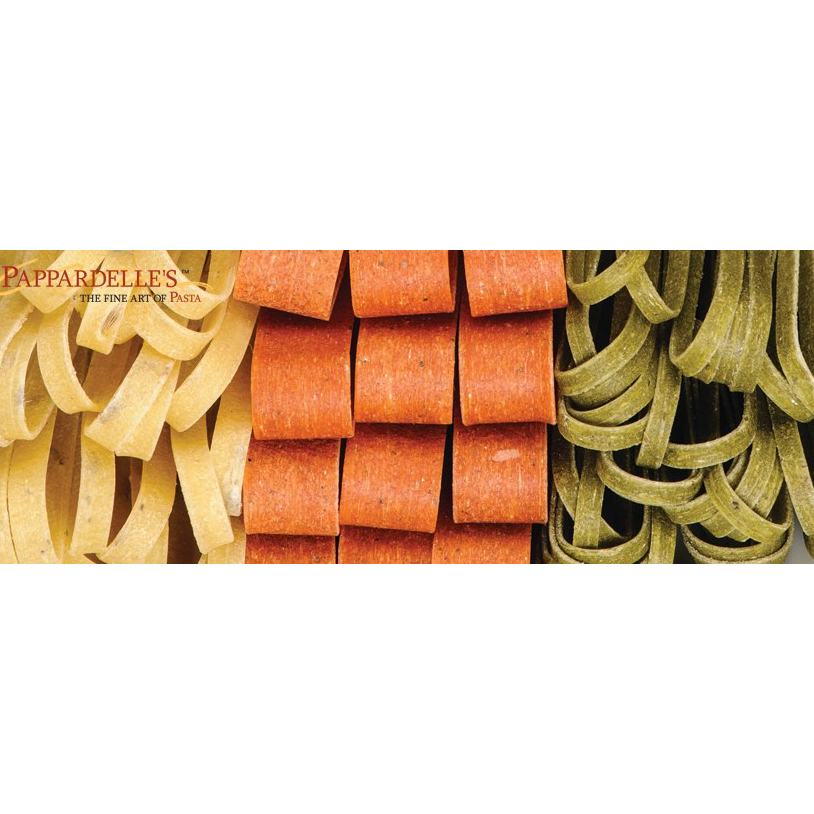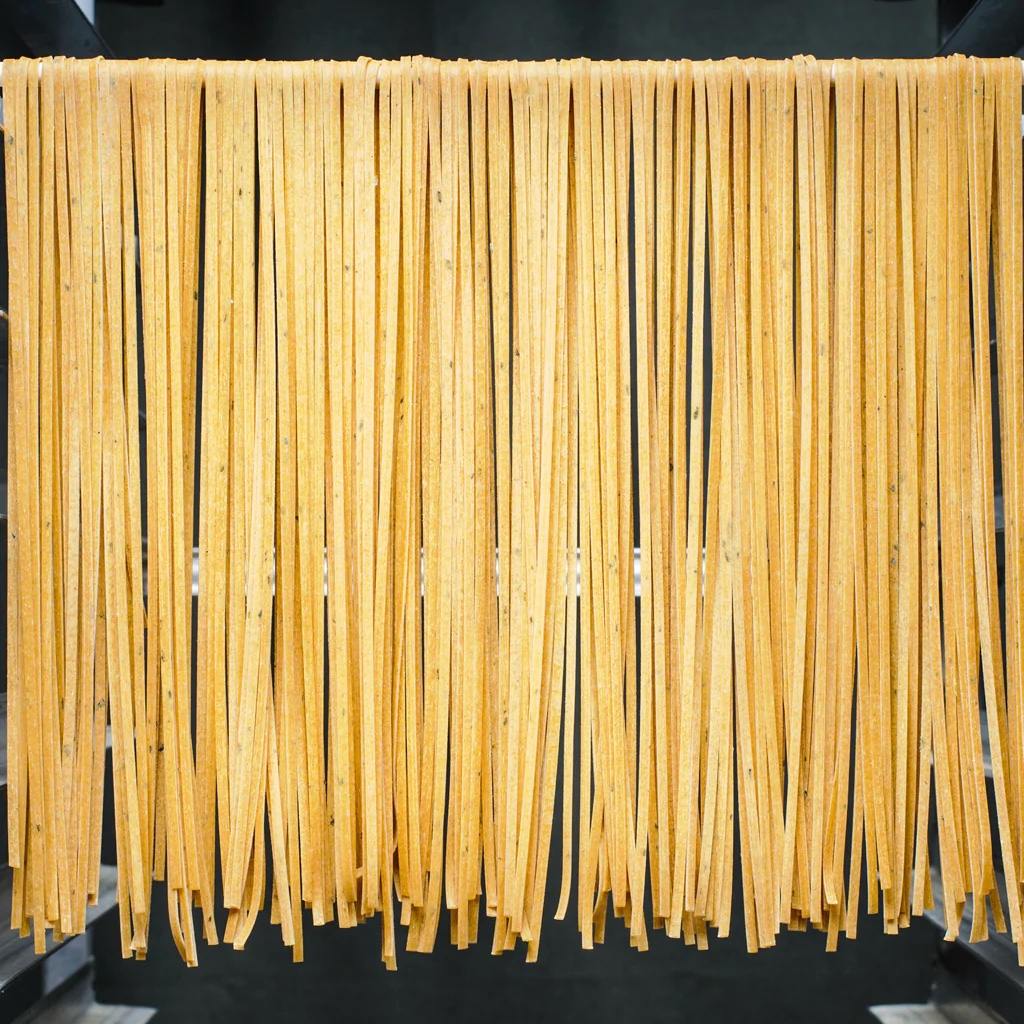Producer


Pappardelle's Pasta
Contact: Maria Caravati
Address: 5901-6th Avenue A Kenosha, WI, 53140
Phone: 262-620-3240
Website: www.lovequinox.com
About Us
Our pasta is produced with the same care and attention to detail that artists use when taking paint to canvas or chisel to stone. Pappardelle’s pasta is a true artisanal food.
And what exactly is an artisanal food? It is made by hand, using the finest-quality ingredients available and following traditional methods of production.
Our pasta makers have an intimate knowledge of every step of the time-honored tradition of making pasta: the flour, the added ingredients, the mixing and extruding, and finally, the drying process. Every one of our products has the touch and oversight of a pasta maker guiding it through the delicate craft of turning flour, water and a variety of herbs, spices, vegetables and fruits into edible art — it takes one of our pasta makers well over a year to hone his or her skills and become a master dough maker. Even members of our packaging team must be carefully trained to assess quality and to handle our products delicately, as theirs is the last touch and chance to make sure every thing is perfect.
And what exactly is an artisanal food? It is made by hand, using the finest-quality ingredients available and following traditional methods of production.
Our pasta makers have an intimate knowledge of every step of the time-honored tradition of making pasta: the flour, the added ingredients, the mixing and extruding, and finally, the drying process. Every one of our products has the touch and oversight of a pasta maker guiding it through the delicate craft of turning flour, water and a variety of herbs, spices, vegetables and fruits into edible art — it takes one of our pasta makers well over a year to hone his or her skills and become a master dough maker. Even members of our packaging team must be carefully trained to assess quality and to handle our products delicately, as theirs is the last touch and chance to make sure every thing is perfect.
Practices
Pasta is sturdy, but during production it can be temperamental — a host of factors can ruin a batch of dough. For example, our process must take into account the nature and moisture level of each raw ingredient, how much water is added during the mixing process and exactly what temperature water is ideal for the particular recipe, how much time is the mix allowed to churn, how much air is applied to the pasta as it is being formed, how much ambient humidity is present and what is the ambient temperature of the dough room.
Aside from ingredient and environmental issues, our pasta makers also have to be trained to operate our often finicky Italian pasta machines, which have been retro-engineered to handle the high torque applied by our intense production techniques and which require more TLC due to their high sensitivity to the extreme wear and tear we place them under.
The “flavorings” we use in our pasta are sourced from the industry’s highest quality producers. We do not use preservatives or unnatural flavorings in our pasta. Everything is natural. For example, we have found the best importer of Szechuan peppers and the highest quality producer of naturally dried oranges to flavor our famous Orange Szechuan pasta.
The durum semolina flour is mixed slowly with water and kneaded in small batches of 100 pounds or less. Scaling up of our production process to higher batch sizes actually results in inferior quality pasta. Once mixing is complete, the pasta dough is then extracted through our bronze dies creating the desired shapes. Pasta dough zips through the common Teflon dies used by most pasta producers, but it labors to get through those made of bronze. The extra effort results in coarser noodles, which feel more luxurious on the tongue and do a better job of gripping sauces.
After the noodle or shaped pasta has been formed, it is carefully dried, an art-form unto itself. The pasta is taken to special rooms we have custom designed to reflect the best of what we’ve learned over our first 25 years. We like to “tease the water” out of pasta by slow-drying it between 24 and 48 hours, making handmade adjustments to the drying process continually during that time.
Each room is specific to the type of pasta to be dried. Imagine, if you will, traditional Italians hand rolling their fresh pasta and hanging it on their clothes lines outside to dry in the soft Mediterranean breeze, the pasta gently swaying to and fro as the hot, humid climate does its thing. That’s exactly what our long-cut drying rooms are designed to mimic. If the pasta dries too fast, it becomes too brittle and fails our quality control. We have no choice but to discard it.
Our short cuts go in a different type of drying room. These are meant to provide a slightly more aggressive breeze so that even the most difficult tubular shapes receive proper air flow both inside and outside of the noodle. Some of our short-cuts are so challenging to dry that they also require staged pre-drying. For example, orzo has a unique “football” shape that makes even-drying of it a tricky procedure. If we fail to perform our special pre-drying, then the water moves too quickly through tiny micro-capillaries in the dough from the internal parts of the pasta to the outer layer, and the orzo will crack and split, making it unusable.
Commercial assembly line pasta is dried at around 190 degrees, but in order to preserve the flavor and nutritional components, we slow dry our long- and short-cut pastas at only 95 degrees. We monitor the drying process at set junctures throughout the 2 - 4 day drying period and make adjustments as needed to ensure that the product dries neither too fast nor too slow. Although time consuming, we know that this method creates a superior product.
Aside from ingredient and environmental issues, our pasta makers also have to be trained to operate our often finicky Italian pasta machines, which have been retro-engineered to handle the high torque applied by our intense production techniques and which require more TLC due to their high sensitivity to the extreme wear and tear we place them under.
The “flavorings” we use in our pasta are sourced from the industry’s highest quality producers. We do not use preservatives or unnatural flavorings in our pasta. Everything is natural. For example, we have found the best importer of Szechuan peppers and the highest quality producer of naturally dried oranges to flavor our famous Orange Szechuan pasta.
The durum semolina flour is mixed slowly with water and kneaded in small batches of 100 pounds or less. Scaling up of our production process to higher batch sizes actually results in inferior quality pasta. Once mixing is complete, the pasta dough is then extracted through our bronze dies creating the desired shapes. Pasta dough zips through the common Teflon dies used by most pasta producers, but it labors to get through those made of bronze. The extra effort results in coarser noodles, which feel more luxurious on the tongue and do a better job of gripping sauces.
After the noodle or shaped pasta has been formed, it is carefully dried, an art-form unto itself. The pasta is taken to special rooms we have custom designed to reflect the best of what we’ve learned over our first 25 years. We like to “tease the water” out of pasta by slow-drying it between 24 and 48 hours, making handmade adjustments to the drying process continually during that time.
Each room is specific to the type of pasta to be dried. Imagine, if you will, traditional Italians hand rolling their fresh pasta and hanging it on their clothes lines outside to dry in the soft Mediterranean breeze, the pasta gently swaying to and fro as the hot, humid climate does its thing. That’s exactly what our long-cut drying rooms are designed to mimic. If the pasta dries too fast, it becomes too brittle and fails our quality control. We have no choice but to discard it.
Our short cuts go in a different type of drying room. These are meant to provide a slightly more aggressive breeze so that even the most difficult tubular shapes receive proper air flow both inside and outside of the noodle. Some of our short-cuts are so challenging to dry that they also require staged pre-drying. For example, orzo has a unique “football” shape that makes even-drying of it a tricky procedure. If we fail to perform our special pre-drying, then the water moves too quickly through tiny micro-capillaries in the dough from the internal parts of the pasta to the outer layer, and the orzo will crack and split, making it unusable.
Commercial assembly line pasta is dried at around 190 degrees, but in order to preserve the flavor and nutritional components, we slow dry our long- and short-cut pastas at only 95 degrees. We monitor the drying process at set junctures throughout the 2 - 4 day drying period and make adjustments as needed to ensure that the product dries neither too fast nor too slow. Although time consuming, we know that this method creates a superior product.
